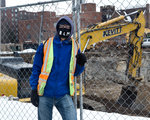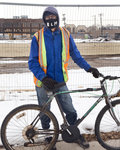



Longfellow resident Joel Albers is compiling a Virtual Community Tour of the George Floyd Uprising that rocked the world last May. The first two installments can be watched on YouTube, along with a 50-second clip of bulldozers razing the intersection of destroyed buildings at 27th Avenue and East Lake Street in December. Five installments in all are planned.
Albers, who works as a health economist and pharmacist at two East African-owned pharmacies, said, “The sheer injustice of George Floyd’s murder drove me to pick up my camera and hit the streets. Underlying racism and economic inequality have shone a mirror on this deep-seated public health crisis. George Floyd’s murder was merciless.”
Albers has been an organizer and health-care activist for a long time. His activism is rooted in grassroots democracy and direct action. He founded a non-profit organization called the Universal Health Care Action Network of Minnesota in 2003. That work has been slow and patient – trying to create health care as a human right, with justice and better access within a system that leaves many people behind.
‘I dropped everything’
On Wednesday, May 27, two days after George Floyd was murdered, the area surrounding the 3rd Precinct was in flames. Albers was out on the street that night and the next, shooting pictures and video with his iPhone.
He said, “There were rubber bullets flying through the air, tear gas, the whole thing. Police officers were stretched out in a long line in full riot gear, and protestors were running everywhere.”
He continued, “I come from a place of non-violent direct action. I’ve spent years traveling around the country, protesting and organizing protests for peace. There was a diversity of people in the crowds that I hadn’t seen before, a lot of young people. Whenever I could, I was filming what I saw – and that was police brutality directed against the protestors.”
Community response
The first video in the series is called “The Minneapolis Uprising: how food/mutual aid unites us all.” The video combines still and moving images, captions, and music.
Albers said, “This is a tribute to the many groups that distributed food and supplies to protestors, among them Seward Café, People’s Pantry Bus, Minneapolis Public Schools, Soup for You, Peace Coffee Food Pantry, All Saints Native American Church, and the medics who volunteered at Holy Trinity Lutheran Church. It was important to document not only the uprising, but also the way the community responded.”
The clean-up along Lake Street has been slow. In December, bull dozers finally came and leveled the charred and broken remains of several buildings at 27th Avenue and East Lake Street, once considered the heart of Downtown Longfellow. Several of these buildings were old, and some had historic value, such as the four-story, brick Odd Fellows Building built in 1908 that anchored the corner.
Albers said, “My point in showing the buildings being razed is that the community needs to step up and reclaim the Minnehaha and Lake area. We’re facing tremendous development pressure from real estate companies, banks, investors, and insurance companies.”
The second film shows both ‘before’ and ‘after’ views of many of the buildings that were damaged or destroyed. It also lists the buildings’ names and the year each was built. Albers also collected data on land and building values, ownership, and property classification.
He summarized, “100 years ago, this area was the hub of the fledgling Longfellow neighborhood. This segment of the virtual tour documents the physical damage to the neighborhood, and is dedicated to the working people who built that intersection into a community. They were Scandinavian immigrants, African Americans, Latinx, Native Americans, East Africans, and other people of color.”
“I’m inviting people to view these films as I put them up on YouTube as a call to grassroots neighborhood action and a way to gain insight into community control of land and buildings. Systemic racism and economic inequality are widely recognized as part of a public health crisis. The George Floyd Uprising has created a turning point – and a historic opportunity to heal from it.”
Joel Albers can be reached at 612.384.0973 or joel@uhcan-mn.org.
Comments
No comments on this item Please log in to comment by clicking here